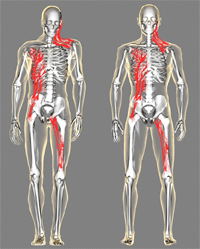
Fascia is a seamless 3-dimensional web of connective tissue that connects every muscle, muscle fiber, nerve, bone, organ and vessels down to the cellular level in our body. Fascia plays an important role in supporting our bodies. Our skeleton acts as “tent poles” which can only stay upright because of the stabilizing pull of the fascial system.

(Image of fascia (web-like structure) surrounding bone and muscle which continues on to surround every muscle fiber down to each muscle cell)
In its healthy state, fascia has a wavy configuration and has the ability to stretch, move and glide within the ground substance (gel-like substance with high water content that occupies the space between the cells and fibers of connective tissue). But in the presence of trauma (emotional or physical), surgery, inflammation, poor posture, faulty movement patterns or repetitive stress on the body, the fascia gets bound down and loses its pliability and the ground substance becomes dehydrated and solidifies. The end result is the development of fascial restrictions that can produce tensile pressures of approximately 2,000 pounds per square inch on pain sensitive structures. Since fascia is an interconnected web that is present throughout the body, a restriction in one area over time, can result to pain and discomfort in other areas of the body. This is referred to as myofascial pain syndrome. Since the pain the client is experiencing does not follow a dermatomal pattern and cannot be detected by standard diagnostics testing such as x-ray, CT-scans, myelograms or electromyography, many might go undiagnosed or even worse, might be told that the pain is “in their head” and there is nothing really wrong with them.

(Fascial restrictions represented by white gauze that is entrapping and putting tensile pressures of approximately 2,000 pounds per square inch on vessels -artery (red), veins (blue) and nerve (yellow)

(“Find the pain, look elsewhere for the cause” (John F Barnes). Client complains of pain on the left side of his neck, which may have been caused by fascial restrictions on the right hip and trunk area.)

Since this technique is most effective when applied directly on the skin, area being treated must be accessible. Also, kindly refrain from using lotion or oil the day of your appointment.
At times during or after JFB MFR treatment, emotions associated with the traumatic experience that may be contributing to the pain or dysfunction through physical holding patterns may come up. It is important for these emotions to be recognized and processed by the client in order for authentic healing to occur.
For more information of JFB MFR techniques, please visit www.myofascialrelease.com
